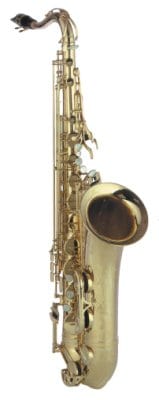Yamaha Z Series Saxophones

|
In the past, when you asked jazz players what they thought of Yamaha saxophones, you heard the same statements: they were "free-blowing", "consistent in construction" and possessed "a great action and nice sound". I admit that those comments sound like compliments, but so does learning that your blind date has a "wonderful personality".
Some players have cast a disapproving glare toward Yamaha saxophones because of one thing: sound. Neither the YAS-62 nor the 875 Custom models offered jazz players the depth, power and focus they needed. Thankfully, Yamaha recognized that trend and now offers the 82Z alto and tenor saxophones. Be prepared: An 82Z is nothing like the little Japanese import you used to tool around with in high school.
In test driving the Z series, I found the horns to be free blowing, consistent in construction, with great action and oh yeah both horns blew the doors off any Yamaha saxophone that I had ever played before. The Zs produce tremendous, centered sound, and the outstanding key action and feel that made Yamahas famous remains. The horns produced an even scale to boot, with excellent pitch and Yamaha's traditional ease of response. Yamaha is marketing the Z series as a modern alternative to vintage saxophones, and while they're not solely jazz horns, they've met with favor from some of jazz's heavy hitters, most notably Phil Woods, who now plays the 82Z alto full time. The Zs have attention-grabbing prices. Retail on the alto (YAS-82Z ) is $3,800 and the tenor (YTS-82Z ) is $4,200. Compared to $4,995 retail for the 875 Custom altos, the prices alone make these new horns worth a second look. Like many saxophones made today, you have options when choosing a new 82Z; lacquered or unlacquered body, as well as an optional, gold-plated G1 neck available for a minimal up-charge. "Custom" owners will enjoy the 82Z's added focus and tonal flexibility. An owner of a vintage horn won't find an 82Z to be exactly like an old Selmer but rather a viable alternative. The Z combines a familiar, "vintage" focus with the ease of a modern action. Comparing the sound of an 82Z with that of a vintage horn is like comparing two versions of the same album, one being on vinyl, the other on CD. Both sound pleasing, but the Yamaha's tone is a bit brighter. Yes, you read it correctly, brighter. What's the secret? The basic concept was to combine the body design of the YAS-62 with the materials of the 875 Custom. But after playing the Z horns, I think there has to be more to the process than this. I don't see how blending two moderately good horns can make such a drastic difference. We'll leave that for the tech-heads to hash out. If you're looking for something specific in your sound, it's worth your while to try out the various options. The unlacquered version offers a fuller, brighter sound, but I enjoyed that option more on the tenor than the alto. The unlacquered alto was almost too bright for my taste, though rock and fusion players might enjoy it. The G1 gold-plated neck added a bit more punch to the sound when used on the alto, but it drastically changed the sound of the tenor. The stock neck produced a nice sound, but the gold neck turned this show pony into a thoroughbred. Yamaha chose simplicity in designing the Z horns. There are fewer posts supporting more of the playing mechanism and less moving parts in the octave mechanism. Repairmen will enjoy the replacement of the ball-and-pin action of the side C and side B-flat keys in favor for the repair-friendly "U" joint. Yamaha has also angled the fork/front F and low C-sharp keys to better accommodate the hand. In fact, the movement from low C-sharp to low B was the best I have ever felt. There were few aspects of the Zs that I didn't like, including the shape of the chromatic F-sharp and the high F-sharp keys. For the 82Zs, Yamaha abandoned the comfortable flat key for the rounded bar style of the old YAS-62. Additionally, my unlacquered test horn had been used before I received it, and whoever played it didn't wipe the moisture from the instrument afterward. There were corrosion marks from the saliva on the exterior of the horn. Those with acidic perspiration or saliva may want to consider the lacquered version or simply give the unlacquered horn more T.L.C. Considering price, construction, and sound, I believe Yamaha has not only answered the call of the modern saxophonist, it has produced one of the most exciting instruments to be unveiled in the new century. Finally, there is an import Z a musician can afford. — Paul Harr Paul Harr is the assistant professor of saxophone and jazz studies at the University of Tennessee. He is active as a performer in both jazz and classical styles. © JazzTimes, Inc. All rights reserved. Reprinted with permission. For more information, write Yamaha Corporation of America, Band & Orchestral Division, P.O. Box 6600, Buena Park, CA 90620; telephone (714) 522-9011 or send e-mail: infostation@yamaha.com. |
 |
| © 2010 Yamaha Corporation of America. All rights reserved. |

